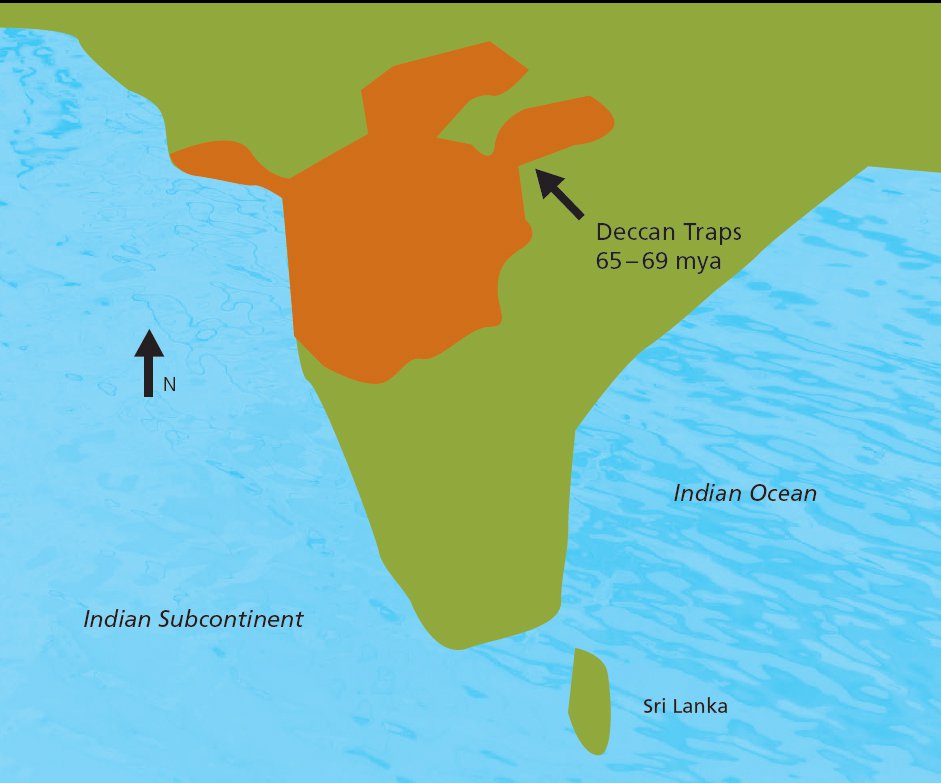The Mesozoic era
Spanning 252 to 66 million years ago... this was the age of the dinosaurs!


Imagine yourself at the dawn of the Mesozoic about 250 million years ago...
Most large animals are reptiles rather than mammals; there are no dinosaurs, no bird sounds, and no flowers to pick or grass to mow. You could even walk all the way from the north to the south pole across one giant continent called Pangaea!
However, this world, and the plants and animals living in it, had changed dramatically by the end of the era.
A spotlight on Australia
Australia in the Mesozoic was nothing like it is today.
It did not exist as a separate landmass, its position on the globe was much further south and the climate and plants were very different. In fact, Australia’s Mesozoic story – and that of its dinosaurs – is inseparable from those of the other landmasses that once formed the southern super-continent Gondwana.

© Australian Museum
Gondwana: the southern super-continent
At the beginning of the Mesozoic, Gondwana formed the southern part of the single continent Pangaea.
When Pangaea split about 200 million years ago, Gondwana began its own isolated journey and gradual break-up into the landmasses we know today – Australia, South America, Africa, India, Madagascar, Antarctica and New Zealand.
This palaeo-history is recorded in identical rocks and fossils found across these modern landmasses. When we reconnect them as they were in the past, the rocks and fossils clearly match up.

Map of Gondwana, showing break-up into modern landmasses and the distribution of key fossils across these landmasses.
Image: illustration© Australian Museum
The Mesozoic extinction event
The Mesozoic came to an abrupt end 66 million years ago in a dramatic extinction event.
Death. Destruction. Devastation. What an ending. We know the outcome, but what was the cause?
Can we really know what happened 66 million years ago? And why does it matter today?
The Mesozoic came to an abrupt end 66 million years ago in a dramatic extinction event. An estimated 70 per cent of plant and animal species perished.
Many theories have been suggested for its cause. The few that are accepted as scientifically valid are placed into two opposing groups. The ‘catastrophists’ believe the mass extinction happened suddenly due to a meteorite impact. The ‘gradualists’ consider it was prolonged and caused by climate change or volcanic activity, with the meteorite only providing the final blow.
Many scientists believe that the impact of one or more meteorites was the major cause of the end-Mesozoic extinction. The idea was first proposed by Alvarez and Alvarez in 1979 based on their analysis of a clay layer in Italy (known as the Gubbio clay layer). This layer yielded extensive amounts of the mineral element iridium. Iridium is scarce on Earth and considered to be meteoric in origin.
This theory gained momentum as further research turned up a variety of supportive evidence from rock layers dating to about 66 million years old. These includes more sites around the world with iridium, possible impact craters, tsunami sediment deposits , shocked quartz and carbon soots.
A large meteorite (about 10-kilometre-wide) hitting the Earth would be catastrophic. Research shows that the effects would include global firestorms, high magnitude earthquakes, tsunamis, acid rain, heating of the atmosphere, and debris and dust that cause prolonged winter. All these would devastate the biosphere, with massive initial fatalities followed by collapse of food chains.
A number of crater sites around the world date to the end of the Mesozoic. The Chicxulub Crater in Mexico is the most likely site of the impact. This 200-kilometre wide crater was accidentally discovered in 1991 by geologists drilling for oil.
The Shiva Crater has also been proposed. This crater is found at the India-Seychelles rift. It would have been about 600 kilometres long and 450 kilometres wide when first formed, but has separated due to sea-floor spreading. If the original meteorite broke into fragments, one could have formed the Shiva Crater while the other impacted at Chicxulub.
It is estimated that a meteorite with a diameter of at least 10 kilometres would have been needed to create a 200-kilometre-wide crater, like the one at Chicxulub. The energy released from a meteorite this size would be about a million times the power of the atomic bomb dropped on Hiroshima in 1945.

© Australian Museum
The map shows six major end-Mesozoic crater sites:
- Chicxulub, Mexico
- Silverpit, North Sea
- Boltysh, Ukraine
- Shiva, Indian Ocean
- Eagle Butte, Canada
- Vista Alegre, Brazil

Closeup map of Mexico, showing meteorite impact site.
Image: illustration© Australian Museum
Shocked quartz has a crystal structure altered by sudden extreme pressure from either violent volcanic eruptions or meteorite impacts. Samples from the end-Mesozoic extinction layer are most likely caused by a meteorite impact.

Shocked quartz
Image: Alan Hildebrand© Alan Hildebrand
This rock sample from New Zealand shows the layer formed during the end-Mesozoic extinction event. Over 200 extinction layer sites around the world have produced elevated levels of the metal iridium. Iridium is rare in the Earth’s crust but relatively common in meteorites.

This rock sample from New Zealand shows the layer formed during the end-Mesozoic extinction event.
Image: illustration© Australian Museum
Sample labels (from top of sample to bottom):
- Recovery zone - Palaeogene rock: contains fossils of marine life, but not as many as before the end-Mesozoic event.
- Dead zone - Palaeogene rock: contains no fossils of marine life except for a small amount of plankton.
- Boundary zone - end-Mesozoic rock: contains high levels of iridium.
- Normal zone - Cretaceous rock: contains lots of fossils of lots of different types of marine life.
Not all scientists agree that a meteorite impact caused the end-Mesozoic extinction. Some suggest that the extinction occurred over an extended period of time due to massive volcanism. They argue that much of the evidence put forward to support the meteorite impact theory could have been due to volcanic activity instead.
The end of the Cretaceous was one of the most intense periods of volcanic activity in Earth's history with a number of sites showing evidence of large scale eruptions. In particular, the Deccan Traps in India cover an area of 800,000 square kilometres. They were formed over a few million years near the end of the Cretaceous when huge volumes of lava were released in a series of eruptions. Other sites of possible massive volcanic eruptions have been found in Cameroon and the Coral Sea.
Large scale eruptions would have resulted in several trillion tonnes of ash and toxic gases, such as sulphur dioxide and carbon dioxide, being pumped into the air. These could cause catastrophic changes to the climate including prolonged winters, seasonal changes, global warming and aridity, along with other impacts such as acid rain, and chemical changes to the ocean surfaces.
The Deccan eruptions certainly affected local flora and fauna, but evidence suggests that it may have had little direct affect on global extinctions. Fossils found around the Traps show that life was resilient in this environment, including dinosaur life.

The Deccan Traps in India cover an area of 800,000 square kilometres. They were formed over a few million years near the end of the Cretaceous when huge volumes of lava were released in a series of eruptions.
Image: -© Australian Museum

Basaltic lava specimen, DR 16555. From the Deccan Traps, India. Late Cretaceous 65 million years ago.
Image: Robert jones© Australian Museum
Another possibility suggested by some scientists is that a variety of factors, none of which were individually decisive, caused the mass extinctions at the end of the Mesozoic. The extinction 'event' took millions of years with the final extinction coinciding with the meteorite impact.
Fossil and geological evidence indicates gradual changes on a global scale were taking place before the end of the Cretaceous. These changes included volcanic activity, shifting continental plates that altered the climate and environment, falling sea levels and mountain building. Significant plant extinctions were occurring at this time and the fossil record in some areas suggests that dinosaur populations were also in decline.
Scientists agree in a number of areas. For instance, they agree that at the end of the Cretaceous the global climate was changing, that there was major continental plate movement and ocean regression, that increased volcanic activity was occurring, that dinosaur diversity was declining and that a meteorite impacted.
However, they differ in their assessment of the evidence and the degree to which each factor contributed to the mass extinction event. Part of the reason they interpret the evidence differently is due to the lack of fossils and sample sites from the end of the Mesozoic (only the northwest USA has been extensively studied). In addition, a lack of knowledge about dinosaur physiology and its role in their extinction, along with why some animal groups died while others survived, makes definitive answers almost impossible.
Finding out what caused the mass extinction is one thing. How and why some groups of animals survived when others did not is another. Unfortunately, gaps in the fossil record and our knowledge about the extinction event mean we may never have all the answers.
A few patterns do emerge. Life in the seas was hardest hit. Many groups of land animals that were either large or warm-blooded, such as non-avian dinosaurs, pterosaurs and primitive birds, also suffered severe losses. Those that survived tended to live in freshwater rivers or lakes, were small, had widespread distributions or were cold-blooded.

Diagram of modern extinction survivors.
Image: illustration© Australian Museum
List of surviving groups (from top to bottom of graphic):
- insects
- molluscs
- mammals
- turtles
- lizards and snakes
- crocodiles
- fish
- birds (theropod dinosaurs)
List of groups that did not survive:
- mosasaurs
- icthyosaurs
- plesiosaurs
- pterosaurs
- theropods (other than birds)
- sauropods
- ornithopods
- stegosaurs
- ankylosaurs
- ceratopsians
Crocodiles and alligators are often viewed as the great survivors from the dinosaur age, and also mistakenly as living dinosaurs. The question is often asked as to why and how they survived this mass extinction when non-avian dinosaurs did not. Firstly, not all crocodile families did survive - in fact, quite a number did become extinct, particularly the large-bodied ones.
A number of reasons have been suggested to explain why the other groups of crocodiles did survive. These include:
- a cold-blooded ability to continue to function at low body temperature and so require less food
- as modern crocodiles have immune systems that can sustain terrible injuries, ancient crocodiles may also have had this ability
- living crocodiles can tolerate long periods of darkness and poor conditions
- many species appeared to live in freshwater environments which were less impacted by the extinction event
- most animals either produce lots of offspring that are left to rear themselves or a small number of offspring that they expend enormous energy raising. Crocodiles are among the few animals that do both, as females lay up to 60 eggs and often protect the nest and young. In some species, both males and females protect the young.
Can we use our fascination with dinosaurs and their ‘extinction’ and be inspired by those that survive today? Birds are a highly successful group with about 10,000 living species but their continued survival, along with that of many other animals, depends largely on us. We are currently contributing to another mass extinction event.

